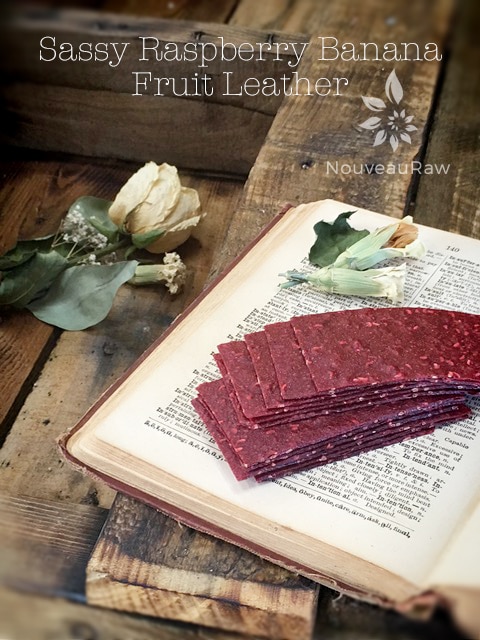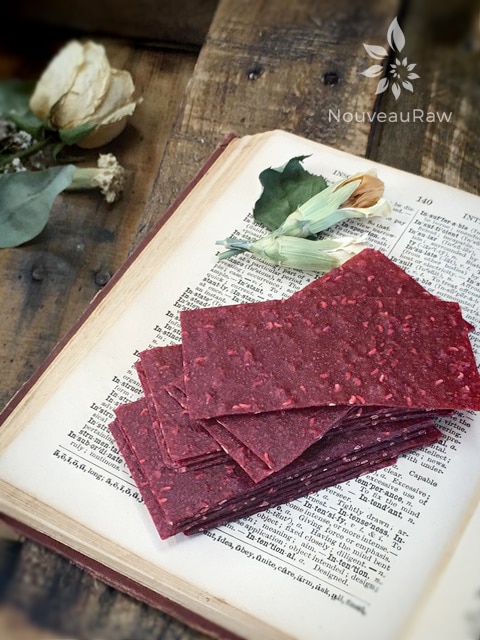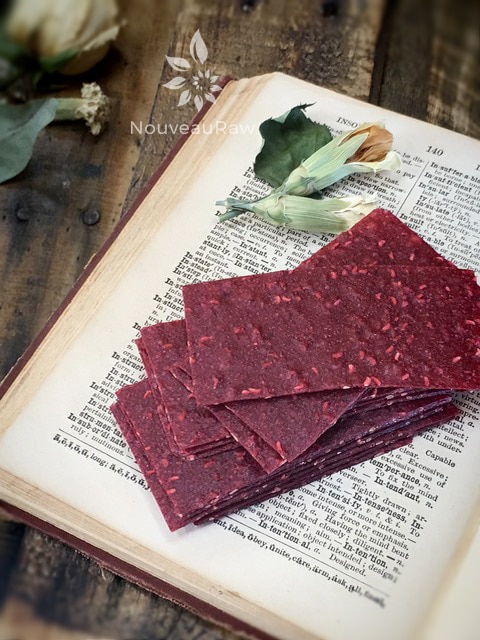Sassy Raspberry Banana Fruit Leather

 Add to favorites
Add to favorites

~ raw, vegan, gluten-free, nut-free ~
The raspberry is a sassy cousin to the strawberry. They are sweet, and tart all rolled into one. One thing that I love about raspberries is that they hold their own.
So, when I went to make this fruit leather, I was sure that the raspberry and banana would pair up just fine, with neither flavor getting lost.
This may sound a little strange, but I couldn’t stop smelling this leather when I took it out of the dehydrator. The raspberry fragrance was so strong and mouth-watering.
Raspberry Fun Facts:
- Raspberries, as well as strawberries, belong to the rose family.
- There are over 200 species of raspberries.
- They can be found in; red, black, yellow, and purple colors.
- They are rich in Vitamin C and have more fiber per calorie than any other common fruit.
Picking Tips:
- It’s best to pick raspberries early in the morning or in the latter part of the day when the temperature is cooler. That way the sun hasn’t had time to soften them, which makes it harder to pick them without smashing them.
- Look for raspberries under the leaves. They like to hide. Pick fully ripe berries that don’t have green or white tips. Handle them with gentle hands. Don’t pile the berries too high in a container; the weight could crush them.
Care and Handling:
- Once picked, protect the raspberries from the sun and heat.
- Remove store-bought berries from the container, discarding any overripe or moldy berries. Don’t wash raspberries until you are ready to use them.
- Keep refrigerated in covered containers.
- The life of a raspberry is very short once picked. So be ready to eat or preserve these wonderful berries.
 Ingredients:
Ingredients:
yields 1 1/2 cups puree
- 2 cups fresh organic raspberries
- 2 bananas, ripe
- 2 Tbsp maple syrup
Preparation:
- Select RIPE or slightly overripe raspberries and bananas that have reached a peak in color, texture, and flavor.
- Puree the fruit and maple syrup, in the blender or food processor until smooth.
- Taste, and sweeten more if needed. Keep in mind that flavors will intensify as they dehydrate.
- When adding a sweetener do so 1 tbsp at a time, and reblend, tasting until it is at the desired taste.
- It is best to use a liquid type sweetener. Don’t use granulated sugar because it tends to change the texture.
- Spread the fruit puree on teflex sheets that come with your dehydrator. Pour the puree to create an even depth of 1/8 to 1/4 inch. If you don’t have teflex sheets for the trays, you can line your trays with plastic wrap or parchment paper. Do not use wax paper or aluminum foil.
- Lightly coat the food dehydrator plastic sheets or wrap with a cooking spray, I use coconut oil that comes in a spray.
- When spreading the puree on the liner, allow about an inch of space between the mixture and the outside edge. The fruit leather mixture will spread out as it dries, so it needs a little room to allow for this expansion.
- Be sure to spread the puree evenly on your drying tray. When spreading the puree mixture, try tilting and shaking the tray to help it distribute more evenly. Also, it is a good idea to rotate your trays throughout the drying period. This will help assure that the leathers dry evenly.
- Dehydrate the fruit leather at 145 degrees (F) for 1 hour, reduce temp to 115 degrees (F) and continue drying for about 16 (+/-) hours. The finished consistency should be pliable and easy to roll.
- Check for dark spots on top of the fruit leather. If dark spots can be seen it is a sign that the fruit leather is not completely dry.
- Press down on the fruit leather with a finger. If no indentation is visible or if it is no longer tacky to the touch, the fruit leather is dry and can be removed from the dehydrator.
- Peel the leather from the dehydrator trays or parchment paper. If it peels away easily and holds its shape after peeling, it is dry. If it is still sticking or loses its shape after peeling, it needs further drying.
- Under-dried fruit leather will not keep; it will mold. Over-dried fruit leather will become hard and crack, although it will still be edible and will keep for a long time
- Storage: to store the finished fruit leather…
- Allow the leather to cool before wrapping up to avoid moisture from forming, thus giving it a breeding ground for molds.
- Roll them up and wrap tightly with plastic wrap. Click (here) to see photos on how I wrap them.
- Place in an air-tight container, and store in a dry, dark place. (Light will cause the fruit leather to discolor.)
- The fruit leather will keep at room temperature for one month, or in a freezer for up to one year.
Culinary Explanations:
- Why do I start the dehydrator at 145 degrees (F)? Click (here) to learn the reason behind this.
- When working with fresh ingredients, it is important to taste test as you build a recipe. Learn why (here).
- Don’t own a dehydrator? Learn how to use your oven (here). I do however truly believe that it is a worthwhile investment. Click (here) to learn what I use.

© AmieSue.com
Tags: Dairy Free, Gluten Free, Nut Free, Refined Sugar Free, Soy Free, sugar free, Vegan



 Add to favorites
Add to favorites
 Ingredients:
Ingredients:
i wanted to do this but with vanilla extract and agave – any recommended amount of extract? thanks!
Hello Nikki,
I would use the same 2 Tbsp of sweetener and then add 1/2 -1 tsp of vanilla. :) Enjoy and let me know how it comes out. Blessings, amie sue